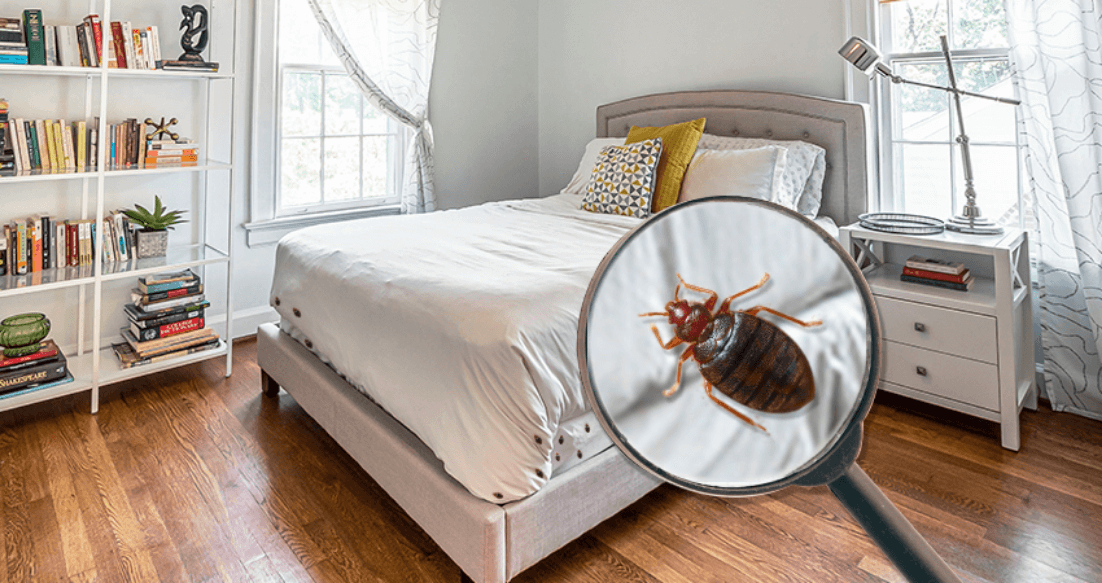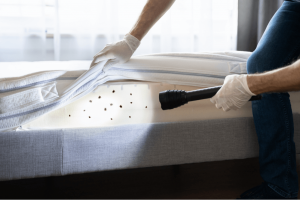How To Find Bed Bugs During The Day
Published Date: August 8, 2022

Bed bugs are the worst. These wingless critters, as their name suggests, prefer to hide in the cracks and crevices of your bed and feed on your blood to sustain themselves. Bed bug bites can cause a host of symptoms ranging from small inflamed spots to a severe skin infection.
They are also notoriously hard to find and deal with, so it’s best to tackle a potential bed bug infestation when you have daylight on your side. Read on to find out how to find bed bugs during the day, draw them out of hiding, and eradicate them in this blog.
How To Identify Bed Bugs

The first step to control and eradicate a bed bug infestation is to identify the characteristics of the culprit. Since these insects look a tad too similar to many bugs out there, it is best to learn about their distinctive appearance and identifying traits. We have compiled a brief list of their features to help.
Bed Bug Eggs
- Tiny, about the size of a pinhead.
- Pearlish white in color.
- If older than 5 days, marked by an eyespot.
Young Bed Bugs/Nymphs
- Tiny.
- Transparent or whitish-yellow in color.
- If not recently fed, practically undetectable due to their size and color.
Adult Bed Bugs
- About the size of an apple seed (5-7 mm or 3/16 – 1/4 inch long).
- If fed recently, balloon-like, reddish-brown, and more elongated.
- If not recently fed, long and brown with an oval-shaped body.
- A “true bug” (short, golden-colored hair, a beak with three segments, antenna that have four parts, and wings that are not used for flying).
How To Find Bed Bugs
If you suspect a bed bug infestation, you should focus on finding it immediately. Treating a small infestation is inconvenient, but it is much less expensive and simpler than handling the same once it has spread widely. However, low-level infestations are also considerably harder to locate.
Signs Of A Bed Bug Infestation

Looking for physical indications of bed bugs is a more reliable technique to spot a potential infestation. When changing the sheets or cleaning, keep an eye out for:
- Bed linens or mattresses with rusty or reddish stains from crushed bed bugs.
- Bed bug excrement appears as dark patches, which could bleed like ink on the fabric.
- Small (approximately 1mm) eggs and eggshells.
- Molted skin of bed bugs as well as the light yellow skins that nymphs shed as they mature.
- Movement of live bed bugs or remnants of dead ones.
Further Reading
Keeping an eye out for signs of pest infestations will help you get rid of them sooner. Find out what these signs are in our blog, “8 Signs That Indicate Indoor And Outdoor Pest Infestation”.
Bed Bugs Hiding Spots

Bed bugs have a variety of hiding spots when they are not feeding. Because they have the same width as a credit card, bed bugs can fit in very narrow areas. If a crack can accommodate a credit card, it can hide a bed bug. They may be everywhere – around the bed, in its cracks, in the bed frame, and headboard as well as close to the piping, seams, and tags of the mattress and box spring.
In a heavily infested home, you can find bed bugs –
- Between the curtain folds, between cushions, and in seams of couches and chairs,
- In the joints in drawers,
- In appliances and electrical outlets,
- Under wall hangings and loose wallpaper,
- Where the ceiling and wall meet,
- And even in screwheads.
A Detailed Process Of Finding Bed Bugs
Now, let’s move onto the process of finding the bed bugs during the day.
Gather Tools
Some tools can be pretty helpful in finding these almost inconspicuous insects. A magnifying glass to zoom in on the blood-suckers and a flashlight for looking into the dark places of the room are a couple of them.
Start Your Hunt
Start by searching for any noticeable signs of these creatures. You can refer to the above list for help. The most common hiding places are your bed or pieces of furniture where they lie waiting for you.
Bedroom
You must carry out an inspection of the furniture in the bedroom. Follow these steps so as not to miss anything.
- Don’t displace any of the items in the room where you suspect the infestation is. Doing so may merely spread bed bugs throughout your home.
- Check any cabinets or bedside tables.
- Look around the exterior for a moment. For instance, the crack between the furniture leg and the carpet might have provided a hiding place for the bed insect.
- Remove each drawer from the furniture (if applicable). Examine the drawer itself, paying close attention to the underside. Additionally, have a look inside the furniture by peering through the opening where the drawer once stood. Repeat for each drawer.
- Flip the piece of furniture over. The majority of bed bugs are probably located here. When you disturb them, you might observe some of them run.
- Continue doing this until every piece of furniture has been examined. It is not likely that any furniture beyond six feet from your bed will have bed bugs unless you are facing a heavy infestation.
Other Places
Although a bed bug would normally prefer the mattress over other surfaces, they may move in a few other directions. Pay close care to any wood-based furnishings in particular. Bed bugs love to enter cracks and joints in wooden furniture.
- Remove the cushions from the couch if they are removable. Check them thoroughly, paying close attention to any piping or zippers. Unzip the couch cushion and take a look inside to make sure there aren’t any bed bugs. Anything that has to be cleaned can be bagged up and thrown immediately into the washing machine afterwards.
- Check the metal or wooden framework by flipping the couch over and looking underneath. If there are bed bugs, they are most likely to be in this area.
- Examine the edges of your rugs and carpets too. Under these soft furnishings, look for holes in the wood floors.
Note: Refer to our list above for other hiding spots of bed bugs.
How Do You Draw Bed Bugs Out Of Hiding?

Bed bugs are attracted to their target (humans or animals) at night by numerous different “lures,” including carbon dioxide, body heat, and many others. You can force them out of hiding and make them simpler to kill by utilizing their natural impulses against them.
A couple of methods you can use are –
Use a hair dryer
To extend the range of your hair dryer, be sure to connect it in the middle of the room. With the help of the intense heat it produces, you’ll be able to evict the bed bugs from their hideouts in difficult-to-reach areas.
Since bed bugs are heat-sensitive, the higher the temperature you subject them to, the better. If you plan to use the hair dryer close to plastics or other objects that could melt or distort, go to a low heat setting instead.
Use a thin card
This method should be used when you actually spot bed bugs. With a card or other thin object, you can drive out the holed up bugs from their hiding place. When you see a group of insects, put the card inside the area where they are present and slowly drag it toward you to remove them.
Hold the card’s edge firmly on the surface while angling it to cover more ground and prevent any bugs from getting a chance to escape. Make sure that it is a little rigid, so you won’t have to be concerned about it inadvertently breaking.
While this is definitely not the best technique to get rid of all the pests, it can help reduce their population.
What To Do After Finding Bed Bugs?
To put it simply, the first order of business should be to eradicate them. Here are a couple of ways you can go about doing that.
DIY

You can start by attempting a chemical-free bed bug extermination. Since high heat at 115°F (46.11°C) or extreme cold at 32°F (0°C) can easily kill these insects, you can try DIYing the bed bug elimination process by using the following methods –
- For 30 minutes, wash your clothes and bedding in hot water. After that, dry them for 30 minutes at the highest heat setting on a dryer.
- Mattresses, couches, and other areas where bed bugs hide should be steam cleaned.
- On a hot day that reaches 95°F (35°C), pack infected objects in black bags and leave them outside or in a closed car. It can take 2 to 5 months to eliminate sealed-up bugs in cooler climates.
- Bedbug-filled bags should be placed in the freezer at 0°F (-17.78°C). Check the temperature using a thermometer. Keep them there for a minimum of 4 days.
Next, make the area uninhabitable for any remaining bed bugs once you’ve eliminated any that are visible. Your mattress and box spring should be covered with bedbug-proof material. Zip up these coverings. The confined bugs within will perish, and new bugs won’t be able to enter.
Note: You might need to try an insecticide if these techniques don’t completely get rid of the pests.
You can also try using chemical treatments. The two substances that are most frequently used to kill bedbugs are pyrethrins and pyrethroids. Some bedbugs, though, have developed a resistance to them.
Desiccants are another option. They are compounds that remove the bugs’ outer layer of defense. The bugs would dry out and perish without this coating. Diatomaceous earth and silica aerogel (Tri-Die and CimeXa) are two examples of dessicants. Bed bugs have not developed a resistance to desiccants, but they tend to work slowly and it may take a few months for these solutions to completely eradicate all pests.
Professional Help

It’s time to call in the experts if you are unable to completely eradicate bed bugs on your own. Companies that deal with pest control have an advantage over you since they can use chemicals and other treatments that are not available to you. They have pesticides that kill bugs instantly and remain inside gaps and furniture to kill bed bugs over time.
Additionally, some of the top pest control companies that deal with bed bugs might heat up a whole room. In order to eliminate bedbugs, they bring in specialized equipment that raises the temperature in the room to between 135 and 145°F (57.22 and 62.78°C).
You should receive preparation instructions from the pest control firm before they come to your house.
Since bed bugs can last a long time and are comparatively harder to get rid of, the price of bed bug treatment/extermination lies on the expensive side. It can range from $300 to $5000 depending on the severity of the infestation.
Find out how much your bed bug infestation can cost you. Get a free quote!
Note: Bear in mind that it usually takes two to three visits for professional treatments to start functioning. Depending on the treatment, you might need to avoid the treated areas for a few hours to allow the pesticides to completely dry.
Conclusion
It can be really annoying to have a bed bug infestation. You could wind up covered in itching, red bites even though they don't spread disease. However, you can take precautions to stop the spread of bed bugs, such as routinely examining your room for indications of the presence of bed bugs or screening your clothing and luggage when you travel. You can also actively start clearing your room of any mounds of clothing where they can hide.
Frequently Asked Questions (FAQs)
When Are Bed Bugs The Most Active?
Bed bugs are generally nocturnal. So they are mostly active at night to feed on either humans or animals and may mostly sleep during the day.
Do Bed Bugs Bite During The Day?
Yes, Bed bugs will come out to prey and bite during the day if they are starving.
Do Bed Bugs Crawl On Walls During The Day?
Bed bugs are sensitive to light and prefer to stay hidden during daytime. However, if they are starving, they may pop up to feed while there’s still light outside. On such occasions and if the place is heavily infested, it wouldn’t be uncommon to spot a bed bug crawling on walls.
Do Bed Bugs Feed Every Night?
Bed bugs don’t have a regular feeding schedule; instead, they only eat when they are in need of a meal and there is a host nearby. When bed bugs eat, they go back to their hiding places until they need to eat again.
Do Bed Bugs Stay On Your Clothes During The Day?
While bed bugs mostly do not venture too far away from their hiding places like a bed or furniture, they can get on your clothes if the place is highly infested. They may even live in stored clothes for a long time until they are displaced. They don’t, however, tend to stay on the clothes you are wearing.
If you are facing this issue, we recommend washing your clothes with hot water and cleaning out your wardrobe or closet with chemicals.
Can You See Bed Bugs With The Human Eye?
Due to their small size, it can be difficult but not impossible to spot a bed bug with the naked eye.
Can Bed Bug Eggs Be Seen?
Yes, bed bug eggs, despite being tiny, can be spotted, especially if you know what they look like and are used to searching for them. They are pearly white and are marked by an eyespot.
How Do You Detect Bed Bugs With UV Light?
Using a UV light to find bed bugs is a good idea as most insects’ shells absorb ultraviolet light and reflect visible light.
Start by clearing your room and bed of any mess or items that may obstruct your vision. Then, draw your curtains and switch off the lights in the room. Turn on your UV light next to start your search and move it across the bed and room to find bed bugs
What Do Bed Bugs Hate The Most?
Bed bugs can be deterred by strong smells. Some of the scents they don’t like and avoid are those of lemon juice, peppered powder, tea tree oil, lavender oil, etc.
What Smells Attract Bed Bugs?
Bed bugs find the smell of dirty laundry appealing as it may seem like a potential host to them. Another smell that can draw bed bugs is that of carbon dioxide as it signals a human’s presence to them.
Can Bed Bugs Be In Just One Room?
Yes, possibly. If the bed bugs’ infestation is just in the initial stages, they might be limited to just the one room. However, as they increase in population, they may move to other rooms in the house.
How Long Does It Take To Know You Have Bed Bugs?
If they are adult bed bugs, you may notice bite marks on your body and other signs after a few days when it becomes a regular occurrence.




